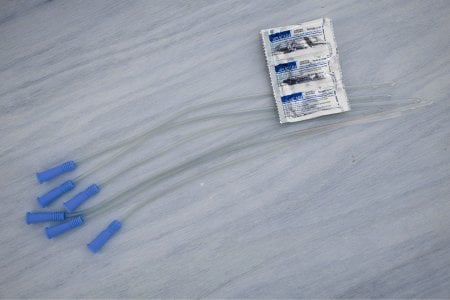What is a Coudé Catheter & Why Should I Use One?

If standard straight-tip catheters don’t work for you, your urologist or other treating healthcare professional may suggest that a coudé catheter is a solution you need. But what is a coudé catheter? And why should you use one?
Designed with a slight bend at the tip, coudé catheters help navigate around obstructions like an enlarged prostate or urethral strictures, making self-catheterization easier and more comfortable. But how do they work, and who benefits most from using one? In this guide, we’ll break down what a coudé catheter is, why it’s different from a straight catheter, and how to know if it’s the right choice for you.
What is a Coudé Catheter and Why Use One?
Whenever a straight catheter isn't easy to insert, your healthcare professional may recommend trying out coudé catheters. Coudé catheters are similar to traditional straight-tip catheters, but they have a curved, angled tip, which can improve and simplify the self-catheterization experience for patients who usually experience discomfort.
Common Reasons People Switch to Coudé Tip Catheters
- Benign Prostatic Hyperplasia (BPH), also known as an enlarged prostate
- Urethral strictures or urethral trauma
- Prostate surgery
- Atrophic vagina
- False passages
Most people who use coudé tip catheters are males, so most coudé catheter lengths are male/unisex (16 inches) or pediatric length (10 inches).
However, your doctor may prescribe coudé tip catheters regardless of your gender if your anatomy does not allow for painless, comfortable insertion with straight tip catheters.
How Does Insurance Cover Coudé Tip Catheters?
It is common for an insurance company that covers catheterization to also cover coudé catheters. This includes, but is not limited to, many state Medicaid programs, Medicare, and other private insurance policies. Your specific coverage dictates the type of catheters and the monthly amount.
Medicare may cover up to 200 catheters monthly, depending on your needs. This allows patients to self-catheterize between six and seven times per day. However, Medicare and some other insurances may require additional documentation that states why coudé catheters are medically necessary.
Patient Care Medical's Catheter Specialists are here to help if you are unsure what your insurance policy covers. We will work with your provider directly to find out how their catheter coverage works and discuss any out-of-pocket costs you may incur. We wish to make the self-cathing process as stress-free as possible, so do not hesitate to contact us with any questions or concerns.
How to Insert a Coudé Tip Catheter Instructions
Before starting to self-cath, you should gather all of the necessary supplies and wash both your hands and the insertion location with soap and warm water. You may also opt to use antiseptic wipes to disinfect the insertion location. You may also put on gloves to reduce further contamination.
- Lubricate the catheter with a sterile, water-soluble lubricant.
- Hold the catheter in one hand and your penis in the other, holding it 45 degrees away from your stomach.
- Slowly insert the catheter into your urethra. If you experience resistance, do not force the catheter and try to relax as best you can.
- Once urine begins to flow, slowly insert the catheter further. Now you may lower your penis to allow the urine to flow normally into the toilet.
- Once you stop urinating, remove the catheter slowly until it is fully removed.
- Dispose of all used catheter supplies.
What Are Some Common Types of Coudé Catheters?
Coudé catheters are made with the same materials as straight-tip catheters, such as red rubber latex, silicone, vinyl, or PVC. Coudé tips are also implemented into the majority of the most common types of catheters, including hydrophilic catheters, pre-lubricated catheters, uncoated intermittent catheters, pediatric-length catheters, and closed-system catheter kits.
Hydrophilic Catheters with Coudé Tip
Hydrophilic catheters feature a unique coating that allows the catheter to react upon exposure to water to self-lubricate. The catheter will remain lubricated throughout insertion, providing a painless and comfortable experience.
Uncoated Intermittent Catheters with Coudé Tip
The most common and basic type of catheter, uncoated intermittent catheters, allows you to lubricate them yourself to better control the amount of lubrication you desire. We carry uncoated intermittent coudé catheters that come in a variety of materials, including red rubber coudé catheters, soft silicone coudé catheters, and vinyl coudé catheters.
Closed System Catheter Kits with Coudé Tip
These catheter kits are perfect for patients who use wheelchairs and are constantly active and on the go. Our closed-system coudé catheter kits feature either a pre-lubricated or hydrophilic coudé catheter with a self-contained collection bag. These kits are great options, especially for a comfortable, discreet, and convenient self-cathing experience.
How Can I Buy Coudé Tip Catheters?
Our catheter specialists at Patient Care Medical work diligently to provide you with the catheter supplies that work best for you. Our online ordering system is easy and fast, allowing you to get your catheter supplies efficiently.
We carry a large selection of catheter types and brands and are happy to assist you every step of the way. From handling the required insurance paperwork to providing free samples so you can find and choose the coudé catheter that feels right for you, Patient Care Medical will go above and beyond to ensure your self-cathing experience as stress-free as possible.
Request Free Catheter Samples
Related Articles





